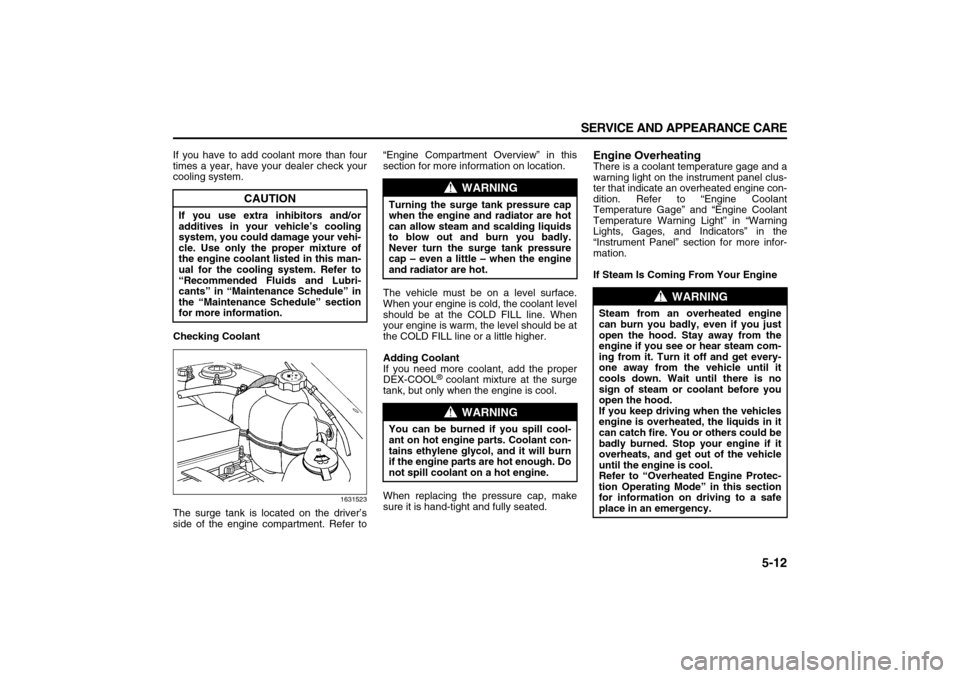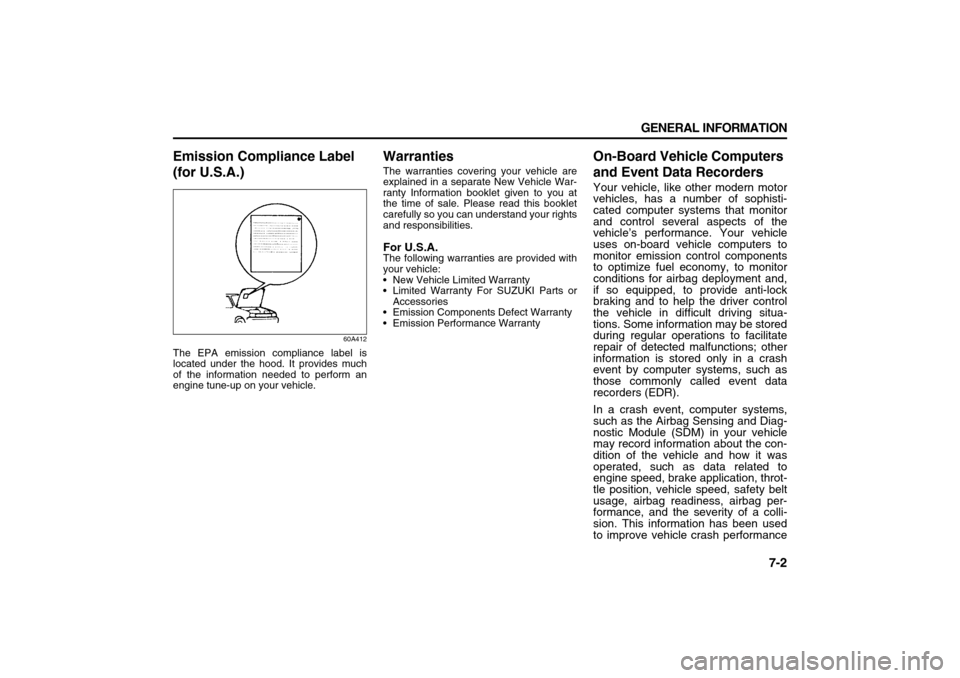ECO mode SUZUKI XL7 2007 2.G Owner's Manual
[x] Cancel search | Manufacturer: SUZUKI, Model Year: 2007, Model line: XL7, Model: SUZUKI XL7 2007 2.GPages: 274, PDF Size: 6.12 MB
Page 154 of 274

3-72 INSTRUMENT PANEL
78J00-03E
Problem Recommended Action
No power. The ignition might not be turned on or in accessory.
The picture does not fill the screen. There are black
borders on the top and bottom or on both sides or it
looks stretched out.Check the display mode settings in the setup menu by pressing the display
menu button on the remote control.
In auxiliary mode, the picture moves or scrolls. Check the auxiliary input connections at both devices.
The remote control does not work. Check to make sure there is no obstruction between the remote control and
the transmitter window.
Check the batteries to make sure they are not dead or installed incorrectly.
After stopping the player, I push Play but sometimes
the DVD starts where I left off and sometimes at the
beginning.If the stop button was pressed one time, the DVD player will resume playing
where the DVD was stopped. If the stop button was pressed two times the
DVD player will begin to play from the beginning of the DVD.
The auxiliary source is running but there is no picture
or sound.Check that the RSE video screen is in the auxiliary source mode.
Check the auxiliary input connections at both devices.
Sometimes the wireless headphone audio cuts out or
buzzes.Check for obstructions, low batteries, reception range, and interference from
cellular telephone towers or by using your cellular telephone in the vehicle.
Check that the headphones are on correctly using the L (left) and R (right)
on the headphones.
I lost the remote and/or the headphones. See your dealer for assistance.
The DVD is playing, but there is no picture or sound. Check that the RSE video screen is sourced to the DVD player.
Page 196 of 274

5-12 SERVICE AND APPEARANCE CARE
78J00-03E
If you have to add coolant more than four
times a year, have your dealer check your
cooling system.
Checking Coolant
1631523
The surge tank is located on the driver’s
side of the engine compartment. Refer to“Engine Compartment Overview” in this
section for more information on location.
The vehicle must be on a level surface.
When your engine is cold, the coolant level
should be at the COLD FILL line. When
your engine is warm, the level should be at
the COLD FILL line or a little higher.
Adding Coolant
If you need more coolant, add the proper
DEX-COOL
® coolant mixture at the surge
tank, but only when the engine is cool.
When replacing the pressure cap, make
sure it is hand-tight and fully seated.
Engine OverheatingThere is a coolant temperature gage and a
warning light on the instrument panel clus-
ter that indicate an overheated engine con-
dition. Refer to “Engine Coolant
Temperature Gage” and “Engine Coolant
Temperature Warning Light” in “Warning
Lights, Gages, and Indicators” in the
“Instrument Panel” section for more infor-
mation.
If Steam Is Coming From Your Engine
CAUTION
If you use extra inhibitors and/or
additives in your vehicle’s cooling
system, you could damage your vehi-
cle. Use only the proper mixture of
the engine coolant listed in this man-
ual for the cooling system. Refer to
“Recommended Fluids and Lubri-
cants” in “Maintenance Schedule” in
the “Maintenance Schedule” section
for more information.
WARNING
Turning the surge tank pressure cap
when the engine and radiator are hot
can allow steam and scalding liquids
to blow out and burn you badly.
Never turn the surge tank pressure
cap – even a little – when the engine
and radiator are hot.
WARNING
You can be burned if you spill cool-
ant on hot engine parts. Coolant con-
tains ethylene glycol, and it will burn
if the engine parts are hot enough. Do
not spill coolant on a hot engine.
WARNING
Steam from an overheated engine
can burn you badly, even if you just
open the hood. Stay away from the
engine if you see or hear steam com-
ing from it. Turn it off and get every-
one away from the vehicle until it
cools down. Wait until there is no
sign of steam or coolant before you
open the hood.
If you keep driving when the vehicles
engine is overheated, the liquids in it
can catch fire. You or others could be
badly burned. Stop your engine if it
overheats, and get out of the vehicle
until the engine is cool.
Refer to “Overheated Engine Protec-
tion Operating Mode” in this section
for information on driving to a safe
place in an emergency.
Page 197 of 274

5-13 SERVICE AND APPEARANCE CARE
78J00-03E
If No Steam Is Coming From Your
Engine
If you get an engine overheat warning, but
see or hear no steam, the problem may not
be too serious. Sometimes the engine can
get a little too hot when you:
Climb a long hill on a hot day.
Stop after high-speed driving.
Idle for long periods in traffic.
Tow a trailer.
If you get the overheat warning with no
sign of steam, try this for a minute or so:
1) In heavy traffic, let the engine idle in
NEUTRAL (N) while stopped. If it is
safe to do so, pull off the road, shift to
PARK (P) or NEUTRAL (N) and let the
engine idle.
2) Set the climate controls to the highest
heat setting and fan speed and open
the windows as necessary.If you no longer have the overheat warn-
ing, you can drive. Just to be safe, drive
slower for about 10 minutes. If the warning
does not come back on, you can drive nor-
mally.
If the warning continues and you have not
stopped, pull over, stop, and park your
vehicle right away.
If there is still no sign of steam, you can
idle the engine for three minutes while you
are parked. If you still have the warning,
turn off the engine and get everyone out of
the vehicle until it cools down. Also, see
“Overheated Engine Protection Operating
Mode” later in this section.
You may decide not to lift the hood but to
get service help right away.
Overheated Engine Protection Operat-
ing Mode
This emergency operating mode allows
your vehicle to be driven to a safe place in
an emergency situation. If an overheated
engine condition exists, an overheat pro-
tection mode which alternates firing groups
of cylinders helps prevent engine damage.
In this mode, you will notice a significant
loss in power and engine performance.
The engine coolant temperature warning
light on the instrument panel will come on
to indicate the vehicle has entered over-
heated engine protection operating mode.
The temperature gage will also indicate an
overheat condition exists. Drivingextended miles (km) and/or towing a trailer
in the overheat protection mode should be
avoided.
Cooling SystemWhen you decide it is safe to lift the hood,
here is what you will see:
1733770
A. Electric Engine Cooling Fans
B. Coolant Recovery Tank
CAUTION
If your engine catches fire because
you keep driving with no coolant,
your vehicle can be badly damaged.
The costly repairs would not be cov-
ered by your warranty. Refer to
“Overheated Engine Protection Oper-
ating Mode” in this section for infor-
mation on driving to a safe place in
an emergency.
CAUTION
After driving in the overheated
engine protection operating mode, to
avoid engine damage, allow the
engine to cool before attempting any
repair. The engine oil will be severely
degraded. Repair the cause of cool-
ant loss, change the oil and reset the
oil life system. Refer to “Engine Oil”
in this section.
Page 198 of 274

5-14 SERVICE AND APPEARANCE CARE
78J00-03E
C. Pressure Cap
If the coolant inside the coolant recovery
tank is boiling, do not do anything else until
it cools down. The vehicle should be
parked on a level surface.
When the engine is cold, the coolant level
should be at or above the cold fill line on
the coolant recovery tank. If it is not, there
may be a leak at the pressure cap or in the
radiator hoses, heater hoses, radiator,
water pump, or somewhere else in the
cooling system.If there seems to be no leak, with the
engine on, check to see if the electric
engine cooling fans are running. If the
engine is overheating, the fans should be
running. If the fans are not running, the
vehicle needs service.How to Add Coolant to the Coolant
Recovery Tank
If you have not found a problem yet, but
the coolant level is not at the cold fill line,
add a 50/50 mixture of clean, drinkable
water and DEX-COOL
® engine coolant at
the coolant recovery tank. Refer to “Engine
Coolant” in this section for more informa-
tion.
WARNING
An electric engine cooling fan under
the hood can start up even when the
engine is not running and can injure
you. Keep hands, clothing, and tools
away from any underhood electric
fan.
WARNING
Heater and radiator hoses, and other
engine parts, can be very hot. Do not
touch them. If you do, you can be
burned.
Do not run the engine if there is a
leak. If you run the engine, it could
lose all coolant. That could cause an
engine fire, and you could be burned.
Get any leak fixed before you drive
the vehicle.
CAUTION
Engine damage from running your
engine without coolant is not covered
by your warranty. Refer to “Over-
heated Engine Protection Operating
Mode” in this section for information
on driving to a safe place in an emer-
gency.
CAUTION
Using coolant other than DEX-COOL
®
may cause premature engine, heater
core, or radiator corrosion. In addi-
tion, the engine coolant could require
changing sooner, at 30000 miles
(50000 km) or 24 months, whichever
occurs first. Any repairs would not be
covered by your warranty. Always
use DEX-COOL
® (silicate-free) cool-
ant in your vehicle.
WARNING
Adding only plain water to your cool-
ing system can be dangerous. Plain
water, or some other liquid such as
alcohol, can boil before the proper
coolant mixture will. Your vehicle’s
coolant warning system is set for the
proper coolant mixture. With plain
water or the wrong mixture, your
engine could get too hot but you
would not get the overheat warning.
Your engine could catch fire and you
or others could be burned. Use a 50/
50 mixture of clean, drinkable water
and DEX-COOL
® coolant.
CAUTION
In cold weather, water can freeze and
crack the engine, radiator, heater
core and other parts. Use the recom-
mended coolant and the proper cool-
ant mixture.
Page 213 of 274

5-29 SERVICE AND APPEARANCE CARE
78J00-03E
Driving, the Road, and Your Vehicle” in the
“Driving Your Vehicle” section.
Intended Outboard Sidewall:
The side of an asymmetrical tire, that must
always face outward when mounted on a
vehicle.
Kilopascal (kPa):
The metric unit for air pressure.
Light Truck (LT-Metric) Tire:
A tire used on light duty trucks and some
multipurpose passenger vehicles.
Load Index:
An assigned number ranging from 1 to 279
that corresponds to the load carrying
capacity of a tire.
Maximum Inflation Pressure:
The maximum air pressure to which a cold
tire may be inflated. The maximum air
pressure is molded onto the sidewall.
Maximum Load Rating:
The load rating for a tire at the maximum
permissible inflation pressure for that tire.
Maximum Loaded Vehicle Weight:
The sum of curb weight, accessory weight,
vehicle capacity weight, and production
options weight.
Normal Occupant Weight:
The number of occupants a vehicle is
designed to seat multiplied by 150 lbs (68
kg). Refer to “Loading Your Vehicle” in
“Your Driving, the Road, and Your Vehicle”
in the “Driving Your Vehicle” section.Occupant Distribution:
Designated seating positions.
Outward Facing Sidewall:
The side of an asymmetrical tire that has a
particular side that faces outward when
mounted on a vehicle. The side of the tire
that contains a whitewall, bears white let-
tering, or bears manufacturer, brand, and/
or model name molding that is higher or
deeper than the same moldings on the
other sidewall of the tire.
Passenger (P-Metric) Tire:
A tire used on passenger cars and some
light duty trucks and multipurpose vehicles.
Recommended Inflation Pressure:
Vehicle manufacturer’s recommended tire
inflation pressure as shown on the tire
placard. Refer to “Inflation – Tire Pressure”
in this section and “Loading Your Vehicle”
in “Your Driving, the Road, and Your Vehi-
cle” in the “Driving Your Vehicle” section.
Radial Ply Tire:
A pneumatic tire in which the ply cords that
extend to the beads are laid at 90 degrees
to the centerline of the tread.
Rim:
A metal support for a tire and upon which
the tire beads are seated.
Sidewall:
The portion of a tire between the tread and
the bead.Speed Rating:
An alphanumeric code assigned to a tire
indicating the maximum speed at which a
tire can operate.
Traction:
The friction between the tire and the road
surface. The amount of grip provided.
Tread:
The portion of a tire that comes into con-
tact with the road.
Treadwear Indicators:
Narrow bands, sometimes called wear
bars, that show across the tread of a tire
when only 1/16 inch (1.6 mm) of tread
remains. Refer to “When It Is Time for New
Tires” in this section.
UTQGS (Uniform Tire Quality Grading
Standards):
A tire information system that provides
consumers with ratings for a tire’s traction,
temperature, and treadwear. Ratings are
determined by tire manufacturers using
government testing procedures. The rat-
ings are molded into the sidewall of the
tire. Refer to “Uniform Tire Quality Grad-
ing” in this section.
Vehicle Capacity Weight:
The number of designated seating posi-
tions multiplied by 150 lbs (68 kg) plus the
rated cargo load. Refer to “Loading Your
Vehicle” in “Your Driving, the Road, and
Your Vehicle” in the “Driving Your Vehicle”
section.
Page 264 of 274

7-2 GENERAL INFORMATION
78J00-03E
Emission Compliance Label
(for U.S.A.)
60A412
The EPA emission compliance label is
located under the hood. It provides much
of the information needed to perform an
engine tune-up on your vehicle.
WarrantiesThe warranties covering your vehicle are
explained in a separate New Vehicle War-
ranty Information booklet given to you at
the time of sale. Please read this booklet
carefully so you can understand your rights
and responsibilities.For U.S.A.The following warranties are provided with
your vehicle:
New Vehicle Limited Warranty
Limited Warranty For SUZUKI Parts or
Accessories
Emission Components Defect Warranty
Emission Performance Warranty
On-Board Vehicle Computers
and Event Data RecordersYour vehicle, like other modern motor
vehicles, has a number of sophisti-
cated computer systems that monitor
and control several aspects of the
vehicle’s performance. Your vehicle
uses on-board vehicle computers to
monitor emission control components
to optimize fuel economy, to monitor
conditions for airbag deployment and,
if so equipped, to provide anti-lock
braking and to help the driver control
the vehicle in difficult driving situa-
tions. Some information may be stored
during regular operations to facilitate
repair of detected malfunctions; other
information is stored only in a crash
event by computer systems, such as
those commonly called event data
recorders (EDR).
In a crash event, computer systems,
such as the Airbag Sensing and Diag-
nostic Module (SDM) in your vehicle
may record information about the con-
dition of the vehicle and how it was
operated, such as data related to
engine speed, brake application, throt-
tle position, vehicle speed, safety belt
usage, airbag readiness, airbag per-
formance, and the severity of a colli-
sion. This information has been used
to improve vehicle crash performance
Page 270 of 274

8-3 INDEX
78J00-03E
Fuses and Circuit Breakers
................................................5-53
GGasoline Octane
..................................................................5-2
Gasoline Specifications
......................................................5-2
Gate Ajar Light
.....................................................................3-25
Glove Box
.............................................................................2-21
HHalogen Bulbs
.....................................................................5-23
Hazard Warning Flashers
...................................................3-3
Head Restraints
...................................................................1-4
Headlamps
...........................................................................3-7
Heated Seats ........................................................................1-2
Highbeam On Light
.............................................................3-25
Highway Hypnosis ...............................................................4-12
Hill and Mountain Roads
.....................................................4-13
Hood Release
.......................................................................5-5
Horn
......................................................................................3-3
How Does an Airbag Restrain?
..........................................1-38
How to Wear Safety Belts Properly
....................................1-11
IIdentification Numbers
........................................................7-1
If a Tire Goes Flat
................................................................5-37
If Your Vehicle is Stuck in Sand, Mud, Ice, or Snow
........4-16
Ignition Positions
................................................................2-12
Infants and Young Children
................................................1-19
Inflation – Tire Pressure
......................................................5-30
Instrument Panel Brightness
..............................................3-8
Instrument Panel Cluster
....................................................3-15
Instrument Panel Overview ................................................3-1
Instrument Panel, Vinyl, and Other Plastic Surfaces
.......5-49
JJump Starting
...................................................................... 5-19
KKeys
..................................................................................... 2-1
LLeather
................................................................................. 5-49
Level Control
....................................................................... 4-21
License Plate Lamp
............................................................ 5-24
Liftgate
................................................................................. 2-7
Loading Your Vehicle
......................................................... 4-16
Lockout Protection
............................................................. 2-6
Loss of Control
................................................................... 4-8
Low Fuel Warning Light
..................................................... 3-26
Lower Anchors
.................................................................... 1-26
Lower Anchors and Tethers for Children (LATCH)
......... 1-26
Luggage Carrier
.................................................................. 2-22
MMaintenance Record except CANADA
.............................. 6-18
Maintenance Requirements
............................................... 6-1
Maintenance Schedule
....................................................... 6-1
Malfunction Indicator Lamp
............................................... 3-21
Manual Lumbar
................................................................... 1-2
Manual Rearview Mirror
..................................................... 2-20
Manual Reclining Seatbacks
.............................................. 1-2
Manual Seats
....................................................................... 1-1
Manual Shift Mode (MSM) (Automatic Transaxle)
............ 2-16
Map Lamps
.......................................................................... 3-9
Mirrors
.................................................................................. 2-20
Multi-Band Antenna
............................................................ 3-74